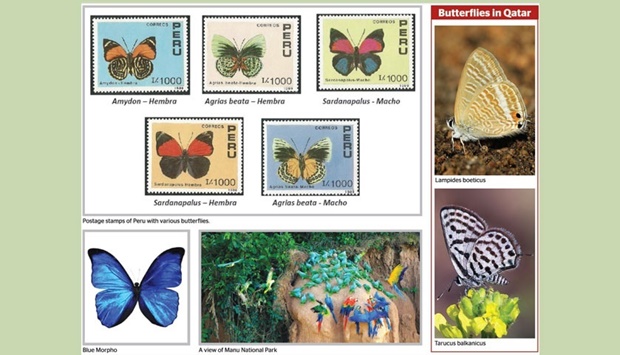• Peruvian nature diversity of its forests has allowed this beautiful creature, with its multicoloured presentation and dimensions, to enrich the wildlife
One of the creatures that nature has offered us to make this world look pretty are butterflies. Lepidoptera is an order of insect of incomparable beauty, whose name comes from the Greek words lepis (scale) and pteron (wing).
Peru, with its great natural diversity, is home to thousands of species of birds, mammals, reptiles and insects, with constant new discoveries; and, butterflies are found in many places, especially in the tropical areas of the Amazon which contains a fifth of the fresh water in the world, and emits more than 20% of the world’s oxygen. It also has a very vast ecosystem.
The Peruvian nature diversity of its forests has allowed this beautiful being, with its multicoloured presentation and dimensions, to enrich the wildlife that we must care about. Peru is one of the countries that hosts the most butterfly species in the world.
It is an amazing specie that normally lives in warm tropical climates and its habitat; nowadays they have been bearing the effects of the destruction of their livelihoods.
They have a short existence, some live a week and some even months, and the life cycle of a butterfly — as we know — goes through several changes which we call metamorphosis: egg, larva or caterpillar, pupa and finally, the butterfly.
For the flora and fauna, these beautiful insects play an important role in the pollination of flowers, thus preserving the environment, and they can fly — according to the species — significant distance looking for their nutrition.
In Peru, there are more than 4,500 thousand species of this winged insect that amaze with their colours, sizes and shapes, which makes it the country with the largest number of species, of approximately up to 10,000 that exist on the planet.
As we have mentioned, they inhabit the Amazon and in the National Reserves such as Tambopata and the Manu National Park in the Madre de Dios region.
This living being that adorns our landscapes with dominance and grace in its flights, with its four wings covered by thousands of scales of various colours, feeds mainly on flower sap with a temperature of 29 degrees.
These species are mono-specific as they only feed from single plant and the Order is divided: the Diurnal and the Nocturnal. Other characteristic of the butterflies is the ability to camouflage themselves to not be vulnerable to predators; an example of this species would be “Owl” in South America.
Furthermore, the butterflies are so fragile, and they spend moments of rest protecting themselves from dehydration.
Currently in Peru, we have places of reproduction of certain species in danger of extinction, work carried out by the state and many organisations dedicated to preserve the environment and various types of denominations of places dedicated to the protection of Mother Nature have been created within the Peruvian legacy.
We would like to mention that one of the emblematic butterflies is the “Blue Morpho” with a blue colour and a large wingspan, which comes in several varieties as they have scales on their wings which are not replaced. In their structure, they have antennae and in their adult stage they feed on the nectar of flowers.
Even now the investigators continue to find out the life of this attractive animal and the preservation of the butterflies that we can see in Mother Nature.
In Qatar, we have witnessed tremendous efforts for afforestation programme and we are certain that we will have the adaptation of many more varieties of butterflies.
As mentioned, Peru is a rich country that brings together thousands of different species, a wonderful wildlife destination of its own beauty and not only because it boasts the Amazon rainforest but also wildlife. Peru is just one of the many spectacular highlights of this formidable travel destination that welcomes you to its unique and rich land.

Postage stamps of Peru with various butterflies. Butterflies in Qatar
